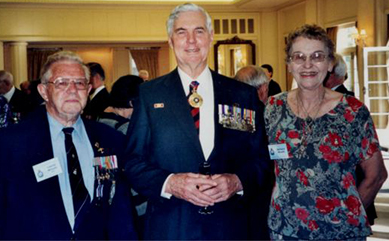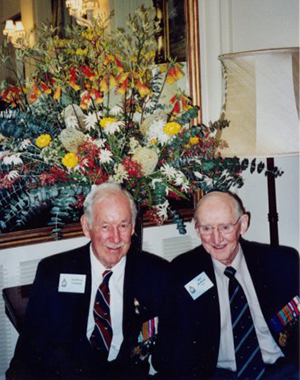
Governor–General Major General Michael Jeffrey with the Queensland president of 460 Squadron RAAF Laurie Woods, and wife Barbara.

Government House, Canberra, 4 December 2003
Mr Laurie Woods DFC, President of the Queensland Branch of the 460 Squadron (RAAF) Association
Mr Jerry Bateman DFC, President of the WA Branch
Group Captain Keith Parsons, Commanding Officer, 460 Squadron
Widows, wives, partners, children, grandchildren, families and friends of 460 Squadron members
Distinguished guests
Ladies and gentlemen
Good afternoon to you all, and a very warm welcome to Government House.
I’m delighted to be hosting this reception, during what is a very important week for everyone associated with 460 Squadron of the RAAF.
People have come to the capital from all over Australia – for some, their first–ever Association reunion.
I’d also like to extend a special welcome to a number of our British friends, who served with Bomber Command.
The Association – and especially Laurie Woods – have done a splendid job in organising what, I understand, is scheduled to be the last national gathering of the Squadron. I know you’ve had a terrific week of reminiscing and seeing old friends – a chance to talk again about the great feats of 460. The reunion will culminate with the opening of the new Striking By Night exhibit at the Australian War Memorial, featuring the refurbished G For George Avro Lancaster bomber. I’ll have more to say about that display at the Official Opening tomorrow night, and I hope to see as many of you there as possible.
Ladies and gentlemen. 460 Squadron of Bomber Command is deservedly recognised as one of the most gallant units in Australian military history, and it should be revered as such. The courage, heroism and self–sacrifice demonstrated by members of the Squadron during World War II was simply extraordinary. You made a very significant contribution to the Allied victory, and we – as a nation – owe you a tremendous debt of gratitude. Your casualties were enormous.

In the modern battlefield environment – where the expectation is for zero or few casualties – the losses you suffered would be neither comprehended nor probably tolerated by today’s public. Of the 2730 airmen who flew operationally with 460 Squadron, 1018 were killed, 201 were taken as prisoners of war and many more were seriously injured. The Squadron was a critical component of Bomber Command, and it set all manner of records. It flew the most sorties in No. 1 Group of the whole of Bomber Command. It suffered the heaviest Lancaster losses in the Group, and the second heaviest in Bomber Command – indeed, the equivalent of being wiped out five times!
460 is also believed to have dropped the greatest tonnage of bombs of any Squadron – 24,000 tons – and it set a monthly record of 1867 tons in August 1944. The casualty rates for the Squadron were appallingly high. According to Group Captain Keith Parsons – who we’re honoured to have with us here today – the "killed in action" rate reached 85 per cent during the peak of fighting in 1943 and 1944. Overall, the 9000 members of the RAAF who served in Bomber Command made a shockingly disproportionate contribution to Australian losses during the War.
They represented fewer than 2 per cent of Australian enlistments in all services, but they accounted for nearly 20 per cent of all Australian combat deaths during the War.
So what was daily life like in 460 Squadron at the very height of the conflict?
I can only speculate, but one would think it was literally a life of blood, sweat and tears, of physical and emotional exhaustion – linked, I would say, with a colossal unit pride to continue at all costs, to never let your crew mates or your Squadron down. Generally, the regime was "six weeks on, six days off". Flying in the planes was noisy, dark, very dangerous and extremely cold – so cold that if bare skin touched metal, it would stick. For a tail gunner, for example, it must have also been extremely lonely. The bombing missions would last for 4–10 hours.
And if the aircrew were lucky enough to get through intense flak and the night fighters to make it home alive and intact, their nerves would be shattered and they would perhaps find it difficult to sleep. There was probably time only to count one’s losses, to be briefed for the next mission, and to patch up the planes for the next run over, say, the heavily defended Ruhr Valley or Italian targets. But through it all, one can sense that there was great camaraderie and a bit of larking about – something heightened by the grim fact that, as one’s tour continued, the chances of death or serious injury grew ever greater.
Ladies and gentlemen. With the passing of 60 years since that conflict, maybe Australia’s collective memory of 460 Squadron is beginning to fade. Nevertheless, I do hope successive generations of Australians will continue to understand and appreciate the supreme sacrifice made by members of 460 Squadron – its air and ground crew alike. They fought and died for the cause of democracy and freedom – for the rule of law and the integrity of the civil institutions we enjoy today.
The 460 Squadron Association plays a vital role in raising and maintaining awareness about the significance of those dark, yet heroic days of World War II. It’s only fitting that – with this week’s return of G For George to the centre stage of the Australian War Memorial – 460’s efforts will again be accorded the position and honour the Squadron deserves.
Ladies and gentlemen. I commend members of 460 Squadron – and, indeed, all members of Bomber Command here today – for your outstanding service to the nation. I hope that you all have a wonderful stay in Canberra, that you enjoy the other commemorative events planned for tomorrow and Saturday, that you have a safe journey home, and that you have a Merry Christmas.
Thank you.